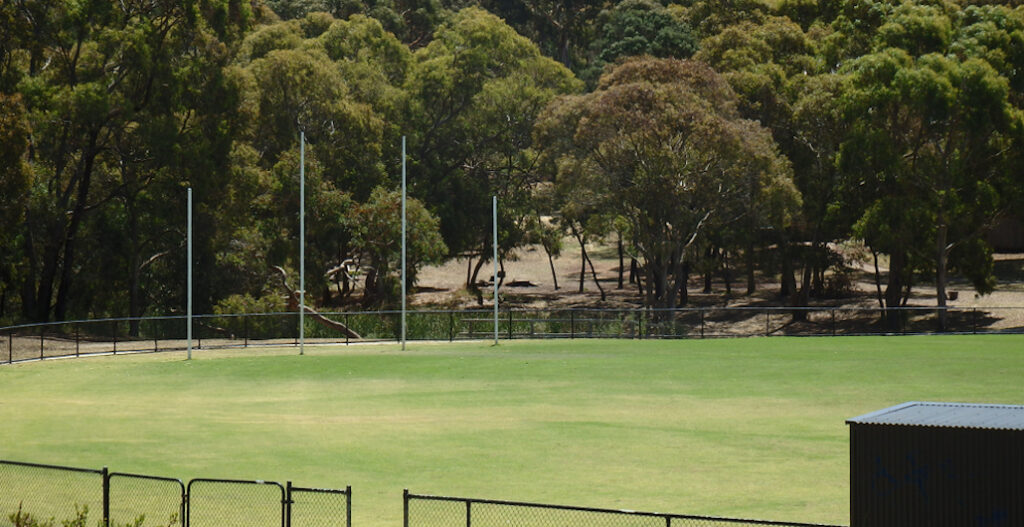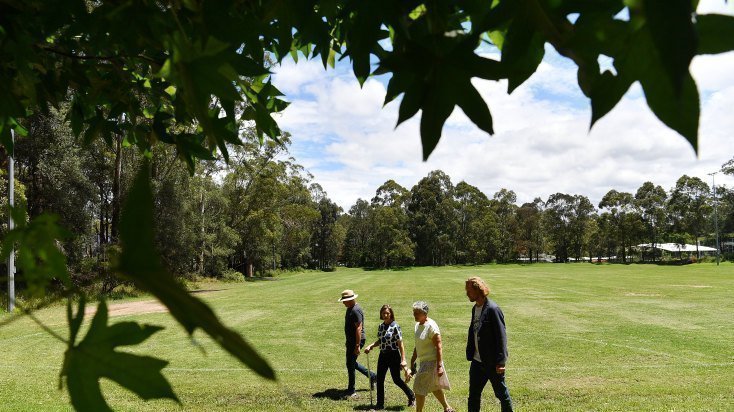An article by Elizabeth Farrelly | 4th July 2023 | ArchitectureAU | Click here to view the article
Elizabeth Farrelly considers an under-acknowledged modernist ally – grass – and how the lazy overuse of synthetic substitutes is leading to overheating, increased toxicity and degradation of the natural and urban environments.
Grass, as a species, is overused, downtrodden and wildly under-acknowledged. Its velvety coolness underfoot as the earth gently exhales on a cicada-spangled evening is just one of its astonishing properties. Now, grass is back in the news – but it’s not the familiar debate over cow-fart. This time, it’s that time-honoured question of whether nature or technology knows best. If nature plays difficult, should we just go ahead and fake it?
Last week, the New South Wales government finally released the chief scientist’s long-awaited report on the dangers of synthetic turf. The report stopped short of recommending a ban on synthetic turf containing toxic “forever chemicals,” as in California and elsewhere, but it did raise significant concerns.
At a meta level, you’d think our species’ lazy and lamentable history of substituting the synthetic for the natural might give us pause. Consider, for example, errors of overreach like industrial food (with its links to epidemic obesity), chemical pesticides (with their links to cancer and bee death) and the replacement of breast milk with formula.
Small, [grass] underpins our food chain, turning sunlight into nutrients. Tall, as bamboo up to 30 metres high, it has the strength and suppleness required for scaffolding and structure.
Yet, the use of synthetic turf – or “astroturf” – is skyrocketing. The chief scientist’s report notes a six-fold increase in four years, from 30 synthetic sports fields in New South Wales in 2018 to around 181 in 2022. (In fact, that count is probably conservative, since it excludes sports like lawn bowls and the growing deployment of synthetic turf in schools and private homes.) Other states are no doubt folowing a similar trajectory.
Before considering the evils of astroturf, though, let’s consider the goodness of natural grass. Grass is versatile. Small, it underpins our food chain, turning sunlight into nutrients. Tall, as bamboo up to 30 metres high, it has the strength and suppleness required for scaffolding and structure. As ground cover, it nurtures an elegant unseen symbiosis with the microbiome, feeding with special sugars the microbes that supply it with absorbable phosphates and other nutrients.
At a symbolic level, grass has long offered egalitarian metaphors – from Walt Whitman’s Leaves of Grass poetry collection (1855) to the idea of “grassroots democracy,” which plays on both its uniformity and its connective underground resilience.
Mostly, though, we in the suburb-ocene consider grass a servant species, both subject and agent in our dominion over nature. In Manet’s 1863 painting Le Déjeuner sur l’Herbe (Luncheon on the Grass), the grass mediates between the sombre, serge-clad commerciality of the men – serious and work-minded – and the woman’s stark white flesh. As nature tamed, grass-as-lawn manifests man’s power to dominate nature and woman, both.
The city would never have been vacated for business had not the entire act of dwelling been sent centrifugally to grass. So perhaps, as both tool and threat, grass was always a candidate for modernism’s competitiveness, its determination to not only dominate nature but outdo her.
This tension between dominance and subversion made grass a modern favourite, yet its potency remains under-acknowledged. Quite as much as steel and concrete, grass was the enabling material of modernity. The city would never have been vacated for business had not the entire act of dwelling been sent centrifugally to grass. So perhaps, as both tool and threat, grass was always a candidate for modernism’s competitiveness, its determination to not only dominate nature but outdo her. Now, grass is seen as little more than an outdoor flooring material. I’m reminded of that old joke about husbands and carpet tiles: lay it properly the first time and you can walk all over it forever.
Which brings us neatly to the idea of faking it. Astroturf, first manufactured in the US in 1966, was always considered the ultimate kitsch. Sadly, we’ve lost those inhibitions and artificial turf is very much on the rise in sports fields across the country. This push is driven by supposedly practical considerations of cost and wear. But how practical is it, actually, to invest in a product whose environmental impacts include water contamination, biodiversity loss, canopy loss, soil death and intensified urban heat? And all this in the face of climate change!
Synthetic grass comprises several layers: the plastic blades, then a layer of infill – most commonly rubber crumb made from old tyres, but sometimes cork – set into a waterproof membrane. Tyres are not manufactured in Australia, meaning we have little or no control over the chemicals contained therein. But rubber crumb – which is used in “safe” children’s playgrounds and sports surfaces as well as synthetic turf – contains heavy metals, volatile organic compounds (VOCs), per- and polyfluoroalkyl substances (PFAs, called “forever chemicals” because they hardly degrade in the natural environment) and other nasties. It is known to leach zinc, rubber polymers and vulcanizing chemicals, including the fabulously named N-(1,3-Dimethylbutyl)-N’-phenyl-p-phenylenediamine-quinone and other toxins that, together, have given rise to the “urban runoff mortality syndrome” observed in salmon exposed to untreated stormwater.
The teeming microbiome dies, leading to soil compaction and root death in nearby trees, which causes more biodiversity loss and shade depletion, and further accelerates degradation of the synthetic materials, intensifying the toxic runoff.
This leachate is marginally less toxic where cork is used as an infill instead of rubber. But in either case, the increased breakdown caused by both Australia’s intense UV radiation, and the extreme heat and rain events associated with climate change, can only accelerate the degradation and subsequent contamination. The fact that Australia’s sporting fields are usually treeless and unshaded, and often located on marginal land that is especially prone to flooding, only exacerbates this. The chief scientist – with input from 24 other highly credentialled academics – estimates that a single Australian synthetic sporting field will generate, per year, 10–100 kilograms of rubber-crumb pollution and hundreds of kilograms of microplastic pollution in the form of lost grass blades.
Then there’s soil death. Synthetic turf’s waterproof layer, pierced only by horizontal or vertical drainage mechanisms, leaves the soil beneath profoundly parched. The teeming microbiome dies, leading to soil compaction and root death in nearby trees, which causes more biodiversity loss and shade depletion, and further accelerates degradation of the synthetic materials, intensifying the toxic runoff.
More dangerous still is the heat. Australia is getting hotter faster than most of the world. Sebastian Pfautsch, an associate professor at Western Sydney University and an expert in urban heat, says that by 2050–60, we could experience three months of days above 35 degrees Celsius. Already, air temperatures hit 50 degrees Celsius in some parts of Sydney. Far from cooling its surrounds as natural grass does, synthetic turf can be several degrees hotter than the ambient temperature, increasing heat-stress on both people and the already degraded soil.
The arguments for synthetic turf hinge on cost of maintenance and intensity of use. But need it be quite so intense? Soil scientist and sports turf specialist Nick Battam notes that, given standard hours of work and school, it is rare for sports field demand to exceed 40 hours per week. And if the usage is any higher, the lifespan of synthetic turf is reduced, raising significant questions about the disposal and recycling of these toxic ingredients, not to mention the cost and embodied energy of replacement. This cost is significant and tends to result in councils barring public access. (Nobody wants doggy-do and chip papers on their expensive plastic grass.) And then there’s the smell, the outgassing, the fungicides used to kill the greeblies that breed in the infill layer …
Rather than offering public land for private development, as the premier of New South Wales Chris Minns proposes, surely it would be better to use such public land to ensure that the necessary densification of our cities is accompanied by enough natural green space. When fully hydrated, properly shaded and equipped with water-recycling and planting programs, such spaces enhance local cooling, biodiversity and carbon absorption. And that’s in addition to the mental and physical health benefits of biophilia. I think it’s called long-term public benefit. Wouldn’t that be a nice change?




